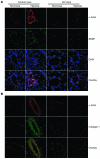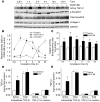Calpain mediates pulmonary vascular remodeling in rodent models of pulmonary hypertension, and its inhibition attenuates pathologic features of disease
- PMID: 22005303
- PMCID: PMC3204840
- DOI: 10.1172/JCI57734
Calpain mediates pulmonary vascular remodeling in rodent models of pulmonary hypertension, and its inhibition attenuates pathologic features of disease
Abstract
Pulmonary hypertension is a severe and progressive disease, a key feature of which is pulmonary vascular remodeling. Several growth factors, including EGF, PDGF, and TGF-β1, are involved in pulmonary vascular remodeling during pulmonary hypertension. However, increased knowledge of the downstream signaling cascades is needed if effective clinical interventions are to be developed. In this context, calpain provides an interesting candidate therapeutic target, since it is activated by EGF and PDGF and has been reported to activate TGF-β1. Thus, in this study, we examined the role of calpain in pulmonary vascular remodeling in two rodent models of pulmonary hypertension. These data showed that attenuated calpain activity in calpain-knockout mice or rats treated with a calpain inhibitor resulted in prevention of increased right ventricular systolic pressure, right ventricular hypertrophy, as well as collagen deposition and thickening of pulmonary arterioles in models of hypoxia- and monocrotaline-induced pulmonary hypertension. Additionally, inhibition of calpain in vitro blocked intracellular activation of TGF-β1, which led to attenuated Smad2/3 phosphorylation and collagen synthesis. Finally, smooth muscle cells of pulmonary arterioles from patients with pulmonary arterial hypertension showed higher levels of calpain activation and intracellular active TGF-β. Our data provide evidence that calpain mediates EGF- and PDGF-induced collagen synthesis and proliferation of pulmonary artery smooth muscle cells via an intracrine TGF-β1 pathway in pulmonary hypertension.
Figures















Similar articles
-
Calpain-2 activates Akt via TGF-β1-mTORC2 pathway in pulmonary artery smooth muscle cells.Am J Physiol Cell Physiol. 2016 Jul 1;311(1):C24-34. doi: 10.1152/ajpcell.00295.2015. Epub 2016 Apr 20. Am J Physiol Cell Physiol. 2016. PMID: 27099352 Free PMC article.
-
BMP4 inhibits PDGF-induced proliferation and collagen synthesis via PKA-mediated inhibition of calpain-2 in pulmonary artery smooth muscle cells.Am J Physiol Lung Cell Mol Physiol. 2017 May 1;312(5):L638-L648. doi: 10.1152/ajplung.00260.2016. Epub 2017 Feb 24. Am J Physiol Lung Cell Mol Physiol. 2017. PMID: 28235949 Free PMC article.
-
Sulfur Dioxide Protects Against Collagen Accumulation in Pulmonary Artery in Association With Downregulation of the Transforming Growth Factor β1/Smad Pathway in Pulmonary Hypertensive Rats.J Am Heart Assoc. 2016 Oct 17;5(10):e003910. doi: 10.1161/JAHA.116.003910. J Am Heart Assoc. 2016. PMID: 27792648 Free PMC article.
-
MicroRNA-663 prevents monocrotaline-induced pulmonary arterial hypertension by targeting TGF-β1/smad2/3 signaling.J Mol Cell Cardiol. 2021 Dec;161:9-22. doi: 10.1016/j.yjmcc.2021.07.010. Epub 2021 Jul 31. J Mol Cell Cardiol. 2021. PMID: 34339758
-
Tear me down: role of calpain in the development of cardiac ventricular hypertrophy.Circ Res. 2011 Aug 5;109(4):453-62. doi: 10.1161/CIRCRESAHA.110.239749. Circ Res. 2011. PMID: 21817165 Free PMC article. Review.
Cited by
-
Activation of calpain by renin-angiotensin system in pleural mesothelial cells mediates tuberculous pleural fibrosis.Am J Physiol Lung Cell Mol Physiol. 2016 Jul 1;311(1):L145-53. doi: 10.1152/ajplung.00348.2015. Epub 2016 Jun 3. Am J Physiol Lung Cell Mol Physiol. 2016. PMID: 27261452 Free PMC article.
-
Protein Expression by Human Pulmonary Artery Smooth Muscle Cells Containing a BMPR2 Mutation and the Action of ET-1 as Determined by Proteomic Mass Spectrometry.Int J Mass Spectrom. 2015 Feb 15;378:347-359. doi: 10.1016/j.ijms.2014.10.006. Int J Mass Spectrom. 2015. PMID: 25866469 Free PMC article.
-
Hemodynamic Characterization of Rodent Models of Pulmonary Arterial Hypertension.J Vis Exp. 2016 Apr 11;(110):53335. doi: 10.3791/53335. J Vis Exp. 2016. PMID: 27167679 Free PMC article.
-
Targeting PDGF/PDGFR Signaling Pathway by microRNA, lncRNA, and circRNA for Therapy of Vascular Diseases: A Narrow Review.Biomolecules. 2024 Nov 14;14(11):1446. doi: 10.3390/biom14111446. Biomolecules. 2024. PMID: 39595622 Free PMC article. Review.
-
Mouse model of experimental pulmonary hypertension: Lung angiogram and right heart catheterization.Pulm Circ. 2021 Sep 8;11(4):20458940211041512. doi: 10.1177/20458940211041512. eCollection 2021 Oct-Dec. Pulm Circ. 2021. PMID: 34531976 Free PMC article.
References
-
- Tuder RM. Pathology of pulmonary arterial hypertension. Semin Respir Crit Care Med. 2009;30(4):376–385. - PubMed
Publication types
MeSH terms
Substances
Grants and funding
LinkOut - more resources
Full Text Sources
Medical
Molecular Biology Databases

